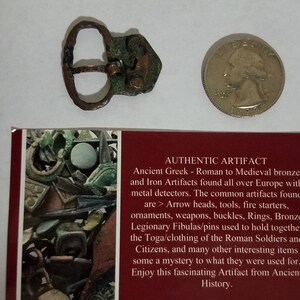

And while some people may seem content with the story as it stands, our view is that there exist countless mysteries, scientific anomalies and surprising artifacts that have yet to be discovered and explained. The three fingers he used to bless people were cut off and his naked corpse was tossed into a commoner’s grave.Īt Ancient Origins, we believe that one of the most important fields of knowledge we can pursue as human beings is our beginnings.
#ROME ARTIFACT TRIAL#
He was dressed in all the fineries of papal vestments and placed on trial where he faced Stephen VI’s accusations of perjury, coveting the papacy as a layman, and violating church canons while he was pope.īeing a rotting corpse at the time, Formosus wasn’t too good at defending himself! He was found guilty, stripped of his robes and deprived of his title as pope.

Pope Stephen VI ordered Formosus’ body to be exhumed. The situation reached the peak of absurdity with the posthumous ecclesiastical trial of Pope Formosus in January 897, an event commonly referred to as the Cadaver Synod (‘Cadaver Trial’). Arnulf also died in 896 at which time Spoleto came to Rome to receive the imperial crown from the newly ordained Pope Stephen VI. Formosus was in the act of raising an army against Spoleto when he died.

Pope Stephen VI supported Arnulf’s rival Lambert of Spoleto. Secular kingdoms and fiefdoms would support a candidate for the papacy in order to reap the benefits of a preferred papal allegiance.ĭuring his reign, Formosus had supported Arnulf of Carinthia in a bid for the imperial crown of the Holy Roman Empire. Caught up in the political machinations of Europe, the Vatican had seen a rapid succession of popes come and go. The 9th and 10th centuries AD were turbulent years for the papacy of Rome. Pope Stephen VI had a seething hatred for the late Pope Formosus. (Giovanni Battista de'Cavalieri / Public Domain ) He was succeeded by Stephen VI.Ĭopper engraving print of Pope Formosus, 1580. Pope Boniface VI lasted for two weeks before he died (either of gout or poison) and his reign was declared ‘null and void’. To stem the unrest, the Church quickly instated Boniface VI as pope. When he died, there were riots in the streets of Rome. Yet for all this, Formosus was loved by the people. He also was persistently bothered by the encroaching Muslims. While in office, Formosus made a lot of enemies in the upper echelons of power in Constantinople, the Holy Roman Empire, Italy, and within the Church itself. In 891 AD, Formosus was elected Pope, a position he held until his death in 896 of a stroke (although some suspect poisoning). Clearly incapable of defending himself, the dead Pope was found guilty on all counts. Nine months after the Pope died, his body was exhumed and his rotting corpse was placed on a throne to face charges. The ‘Cadaver Trial’ of the dead Pope Formosus would have to be one of the most absurd events in Rome’s history.


 0 kommentar(er)
0 kommentar(er)
